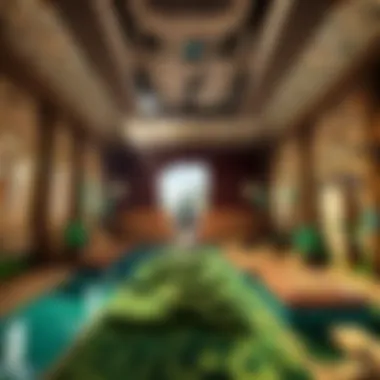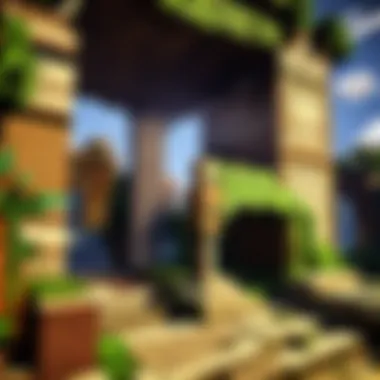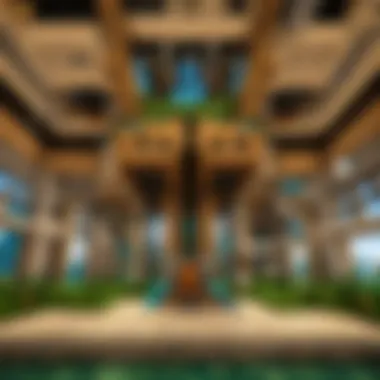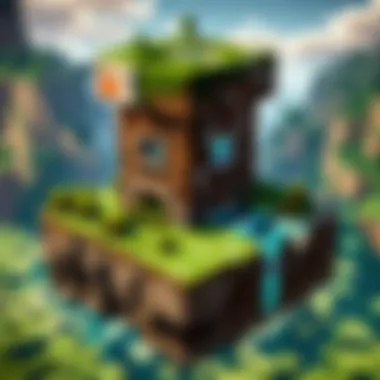Exploring Minecraft's Role in Modern Education


Intro
The exploration of Minecraft in an educational context is a subject of mounting interest. In the last decade, it has become increasingly evident that this game can effectively blend fun and learning. Educators are discovering its potential to foster engagement and creativity while facilitating knowledge acquisition.
As we probe this intersection of education and gaming, we reveal the complexities of incorporating Minecraft into pedagogy. This article aims to provide a comprehensive overview intended for educators, students, and enthusiasts alike. By examining various facets of the game and its application, we can understand why Minecraft exists beyond a simple pastime.
Minecraft Game Guides
To engage students effectively, a sound grasp of Minecraft’s versatile features is essential. The following guides outline significant aspects that educators and learners can harness:
Character Creation Guide
Minecraft allows players to curate their character, offering a chance to introduce students to topics such as identity and customization. Players can configure skin and characteristics, enhancing personal engagement.
Building Techniques Tutorial
Building in Minecraft is more than just stacking blocks. Knowledge of architectural principles can enhance this activity. Here’s how:
- Learn basic architecture concepts.
- Incorporate engineering principles.
- Explore landscape design.
demonstrating real-world applications.
Redstone Mechanics Explained
Redstone, often referred to as Minecraft's version of electricity, introduces concepts of logic and problem-solving. Through practical applications:
- Build simple circuits.
- Create automated structures.
These activities are conducive to discussing core principles in STEM curricula, supporting interdisciplinary approaches to learning.
Crafting Recipes Encyclopedia
Understanding crafting recipes is fundamental to survival in Minecraft. Continuous practices in these scenarios help develop critical thinking abilities. Learners can delve into resource management, consider trade-offs, and explore systematic approaches to challenges. The lists of recipes can become a collaborative space for shared discoveries.
Crafting serves as a practical hands-on exercise to enhance problem-solving: often requiring evaluation and adjustment for effectiveness.
Educational Framework of Minecraft
A Minecraft education framework includes integration into several curricular areas. Content relevancy allows exploration from linguistic studies to environmental science. Via competitions and projects, students develop their understanding intuitively within a kinesthetic environment.
Student creativity often flourishes when given autonomy. Minecraft supports vast themes in virtually all subjects. A few compelling aspects include:
- Analytic skills: Critical thinking through spatial planning.
- Team collaboration: Creating with peers builds communication skills.
- Civic Responsibility: Engaging in community servers teaches collaboration and ethics.
Encouraging deeper interaction fosters meaningful learning experiences. Overall, Minecraft can often transcend traditional teaching methods, creating immersive educational environments that respond to modern learning needs.
Latest Updates and Patch Notes
Keeping up with Minecraft updates is vital. Such awareness allows educators to utilize the latest learning features effectively. Organizing materials, both logistically and curriculum aligned, makes learning paths smoother for students.
Feedback from users has increasingly influenced future updates. In the following section, we analyse updates that shape interaction and engagement:
- Patch Note Breakdown
- New Features Analysis
- Community Speculations and Theories
Recognizing real-time developments serves to enhance the educational experience, offering educators new tools for expansion and engagement.
Prelims to Minecraft as an Educational Tool
The world of education is transforming rapidly, and within this landscape, Minecraft has emerged as a compelling resource. This section will explore how Minecraft serves as an effective educational tool, breaking the boundaries of traditional learning environments. Given its interactive nature, it naturally captivates the imagination of both children and adults. The goal is to understand how it fosters creativity, encourages collaboration and supports problem-solving skills.
Overview of Minecraft
Minecraft is a sandbox game that allows players to create, explore, and survive in a blocky, procedurally generated 3D world. The appeal lies in its open-ended gameplay where personal creativity is at the forefront. Players can build structures, craft items, and interact with others in various game modes. This freedom makes it an attractive tool for educators, providing numerous opportunities to engage learners. The simplicity of its design can obsure important learning experiences hidden beneath the interface, inviting discussion on various themes ranging from engineering principles to historical conversations, depending on how it is approached in the classroom.


The Educational Value of Gaming
Educational theorists point to gaming as an engaging way for students to learn vital skills. This perspective challenges the age-old criticism that video games serve purely for entertainment. Rather, gaming holds a distinct educational value by enhancing cognitive abilities as well as soft skills. Through gameplay, learners experience:
- Critical Thinking: Players think ahead, analyze situations, and adapt strategies to navigate challenges effectively.
- Collaboration: Many modes of Minecraft encourage teamwork and communication, teaching important interpersonal skills.
- Motivation: The intrinsic rewards within the game structure incentivize players to push boundaries in learning.
- Creativity: As a platform, Minecraft offers infinite possibilities for design and construction, promoting innovative thought.
Educators recognized these benefits early on and have implemented Minecraft into curricula effectively. The viability of integrating gaming in education extends beyond just pleasure or leisure; it opens gateways for varied learning experiences that can be measured, analyzed, and developed for individual success or community goals.
The narratives constructed within Minecraft serve as a launching point for exploration, problem-solving, and real-world connections that traditional models often overlook.
Examining the role of gaming ensures a deeper understanding of not only the lines of connection between learning processes and game design but also how best to integrate these insights in classroom scenarios. As attention turns toward progressive pedagogical strategies, embracing games like Minecraft within educational contexts no longer questions their legitimacy; rather, they unveil new paths toward comprehensive understanding across disciplines.
Key Features of Minecraft Relevant to Education
The educational impact of Minecraft does not stem merely from its popularity as a game; rather, it involves distinct characteristics that make it a valuable resource in educational settings. Understanding these key features is important as they lay the groundwork for how educators can effectively integrate the game into their teaching methods. These distinct elements, such as creative and survival modes, customization, modding capabilities, and opportunities for collaboration and social interaction, provide a robust framework for engaged learning.
Creative and Survival Modes
Minecraft offers two main play styles: creative and survival modes, which add dimensionality to the learning experience. In creative mode, players have access to unlimited resources, enabling them to build and create without the limitations found in survival mode. This fosters imagination and creativity. Such characteristics are helpful in projects that require blueprint creation, architectural design, and artistic expression.
Diving into survival mode, on the other hand, introduces a sense of challenge and problem-solving. Players must gather resources, manage health, and fend off conflicts. Learning through this model encourages critical thinking and perseverance. For educators, these contrasting modes present unique opportunities to structure lessons that align with various learning objectives.
In educational frameworks, these modes can serve different purposes:
- Creative mode generally supports design-thinking exercises, allowing students to learn to formulate concepts visually.
- Survival mode can engage students in discussions centered around resource management and prioritizing tasks, valuable skills in any profession.
Customization and Modding
A significant advantage of Minecraft is its focus on customization and modding capabilities. Students can create custom structures or modify existing game features, tailoring their environment to embrace personal interests or learning affinities. Customization can involve designing textures or altering game mechanics, which inspires both voimeration and digital literacy.
Modding, on the other hand, introduces elements of programming and game design. By learning how to create or adapt mods, students become familiar with coding principles. They not only engage creatively but also gain technical skills that have real-world applications in areas of software development and game design.
Some potential education-focused applications of modding include:
- Building specific coding principles into the gameplay dynamically.
- Creating mods that simulate real-world scenarios, such as Vorstellung in the natural science.
- Enhancing collaboration among students to develop and test mods together.
Collaboration and Social Interaction
One of the standout features of Minecraft is its collaborative gameplay. Many projects can be initiated and developed in a group, allowing participants to communicate, brainstorm and collectively create. This aspect is critical in fostering essential skills such as team work, leadership, and conflict resolution which are ggreatly valued in today’s job market.
Teachers can utilize Minecraft to set group projects where students are challenged to work together towards a common goal. They will have to divide tasks, share resources, and negotiate design elements. This mimics real-life scenarios, integrating social skills with educational objectives. Group gaming can also highlight different perspectives and creative problem-solving approaches among students.
The array of key features in Minecraft demonstrates potential assets in changing traditional educational structures, shaping how students engage with material, and helping educators execute complex curriculums more effectively.
In essence, understanding the key features of Minecraft allows educators to appreciate the rich pedagogical benefits it offers. By leveraging these unique aspects, educators can craft learning experiences that resonate well with students and enhance their educational journey.
Incorporating Minecraft into Curriculum
Incorporating Minecraft into education offers significant opportunities for enhancing student engagement and providing immersive learning experiences. The game serves as a creative environment where students can interact creatively within the world of blocks. Utilizing playful learning can help bridge formal academic requirements with constructive play, making learning relevant and enjoyable.
Benefits of integrating Minecraft into the curriculum include the capacity to provide hands-on learning experiences and promote critical thinking. Its multifaceted nature makes it applicable across various subjects, allowing teachers to draw connections to real-world scenarios and thus increase student investment in their studies. This leads to an enriching educational ecosystem, which nurtures both academic and personal development.
Subject-Specific Applications
Mathematics
In the realm of mathematics, Minecraft can serve as a valuable teaching tool by allowing students to apply mathematical principles in a tangible or visual format. In-game activities such as building structures can help students understand geometry, area, and volume. The process of creating elaborate buildings requires mathematical calculations, making learning relevant and practical. Custom challenges such as measuring dimensions or estimating resource needs engage students, encouraging them to experiment and problem-solve in new ways. Its visual learning aspect is particularly compelling, as complex calculations can be readily represented.
However, relying solely on digital environments like Minecraft for learning can occasionally disengage students that thrive on more traditional methods. Thus, finding a balance among various teaching techniques remains essential and could be a suggested consideration.
Science
In science education, Minecraft introduces dynamic methods for students to investigate ecosystem systems and environmental phenomena. Students can experiment with agriculture, biology, and physics creatively, simulating real-life environments within the game. Furthermore, conducting experiments like building physics-based mechanisms or learning about material properties provides context to scientific theories.


This aspect of engagement in scientific concepts makes Minecraft a popular choice among educators, fostering curiosity and motivation among students. Planned activities can lead to regarded inquiry-based learning, enabling discovery through exploration. Yet, if not properly structured, students may drift into play without achieving concrete educational outcomes, so clear parameters are essential.
History
History lessons can see enhanced engagement through Minecraft by simulating historical eras and events. Students can recreate significant monuments, towns, or battlefields, Readying them for discussions about respective historical contexts; this visual representation is invaluable.
The ability to work collaboratively on projects allows for a richer exploration of history and can bring abstract concepts to life. Such immersive learning experiences lead to curiosity and connection with historical timelines. Nonetheless, while absorbent, this nonlinear exploratory method may result in less focus on core material, hence guidance from educators remains paramount.
Project-Based Learning Opportunities
Project-based learning settings integrated with Minecraft supports autonomous academic exploration amongst learners. Through collaborative ventures, students formulate thoughts creatively, boosting ownership over their education. They master the skills of teamwork, organization, and planning— competencies that will serve them beyond school walls.
The Role of Educators in Minecraft Education
The application of Minecraft within educational contexts inherently requires the active engagement of educators. This section discusses why educators have an irreplaceable role in integrating Minecraft into educational settings. First, educators are instrumental in interpreting educational standards and aligning them with the game’s mechanics. They understand how to leverage Minecraft’s features to enhance learning outputs effectively.
Educators can facilitate learning during gameplay by encouraging students to apply problem-solving skills and creativity. Moreover, their guidance helps foster a classroom environment where students feel safe to express ideas, take risks, and evaluate their successes and failures.
Challenges might arise with the misinterpretation or ineffective implementation of Minecraft as a pedagogical tool. Hence, training educators adequately becomes a critical aspect of successful integration.
Training Educators for Implementation
Training educators for implementing Minecraft involves structured approaches. Educators need various skill sets specific for leveraging Minecraft in the classroom. First, technical proficiency with the game is essential, as familiarity leads to better control and implementation during lesson plans.
In addition, teachers require understanding of specific educational goals each session aims to achieve. Workshops and interactive sessions can aid educators in grasping how to design and adapt curriculums using Minecraft. Resources are crucial for training; professional organizations can offer valuable materials while schools often need to prioritize initial investment in resources as a foundational structure.
Proper training elevates the educator’s confidence in using Minecraft and equips them with strategies that engage students skillfully, crafting immersive and meaningful learning experiences.
Creating Engaging Lesson Plans
Creating engaging lesson plans using Minecraft requires teachers to be innovative and thoughtful. Each lesson should have clear objectives aligned with learning outcomes drawn from curriculum standards. Collaboration is essential in devising units that integrate Minecraft uniquely.
Some helpful strategies for crafting effective lesson plans include:
- Leveraging Themes: Incorporate themes from subjects like math or history directly into challenges within Minecraft.
- Incorporating Assessments: Regularly suggest assessments within the game to gauge student understanding effectively.
- Creating Storylines: Develop engaging narratives that can involve students’ interests to foster dedication.
Consequently, flexibility is important; not every task will work for all students, hence the necessity for collaboration and mediation to shape lessons personalized to individual or group needs. Using Minecraft as a central tool for creativity allows students to explore ideas deeply.
Exploring Minecraft Education Edition
Minecraft Education Edition serves as a specialized adaptation of the original game, tailored specifically to educational settings. The importance of exploring this edition lies in its unique emphasis on enhancing the learning experience for students. Through its features crafted for teaching, this edition allows educators to leverage Minecraft's engaging ecosystem while addressing curricular objectives. It has become an empowering platform where educators can harness student creativity and collaboration—elements that are increasingly crucial in today’s learning environment.
Key benefits of Minecraft Education Edition are its alignment with educational standards and its capacity to foster digital literacy among students. The graphical interface remains user-friendly, ensuring that both teachers and students can easily navigate its possibilities. Additionally, the classroom-based tools incorporated into this edition ensure that both real-time assessment and interactive techniques can be seamlessly integrated into classroom practice. Such aspects make it a desirable choice in diverse educational landscapes.
Features Unique to Education Edition
Minecraft Education Edition brings forth several exclusive features that enhance its adaptability in a classroom setting. Firstly, educators have access to a specialized set of tools within the game like the Teacher Dashboard. This allows teachers to create and manage worlds for their students with straightforward controls. Furthermore, built-in lessons reflect essential skills, allowing teachers to engage students on different topics easily.
Learning through play can structure student objectives using assignments generated by the 'Code builder' which assists in teaching programming fundamentals. Moreover, Classroom mode permits seamless teacher-student interaction, making engaging lessons far smoother.
"Utilizing specific features of the Education Edition can lead not only to enhanced engagement but also to a more profound understanding of the subject matter among students."
Licensing and Accessibility for Schools
Licensing for Minecraft Education Edition has been designed with schools in mind, providing package deals that can fit multiple educational institutions. With options for subscriptions or site licenses, the strategy ensures that districts and schools can implement it without excessive financial strains.
Accessibility rules also highlight the commitment to equitable learning environments. Not only is the game available for various platforms, such as Windows, Mac, and iPad, but it is also designed to cater to students with diverse needs. Settings can be customized based on the individuals takes, focusing specifically on various abilities and styles.Ongoing support is available through educational resources, ensuring a lasting integration of Minecraft in learning.
These strategic adaptations signify a transformative step toward embracing digital age learning, aiding institutions across the globe in creating dynamic learning spaces that resonate with students.
Challenges in Utilizing Minecraft for Education
Implementing Minecraft as an educational tool presents several challenges that must be considered to optimize learning. While the game offers numerous benefits, such as engaging players and enhancing creativity, its use is not without concerns. In this section, we will explore some governance issues regarding screen time, learning styles, and provide a well-rounded view of the inherent difficulties when integrating gaming into education.


Addressing Screen Time Concerns
One of the primary concerns educators and parents voice is the amount of screen time associated with video games. As digital learning becomes more common, it's vital to determine a balance that promotes effective education while protecting students' physical and mental well-being. Studies have shown that excessive screen exposure may cause various problems, including eye strain, hindered physical activity, and sleep disturbances.
The American Academy of Pediatrics divides children's screen time into two categories: recreational use and educational use. Although Minecraft falls into an educational category when used appropriately, the key lies in moderation. Incorporating other learning methodologies and activities prevents overwhelming students with screen-overloaded schedules. Combining pass-time gaming with rich, hands-on experiences can foster more thorough knowledge acquisition. Important metrics to consider include the following:
- Total screen time hours given for learning per week
- Instructional environments that utilize alternative methods
- Role as an active observer in fostering Minecraft gameplay education
Managing Different Learning Styles
Education is not a one-size-fits-all solution, and learners possess diverse styles that inflect how they interact with the material. While Minecraft's immersive and interactive nature caters to visual and kinesthetic learners, some students may struggle to adapt. Understanding various learning styles and their influence on gaming activities is alia key challenge in the educational gaming realm.
The core components of different learning styles include:
- Visual Learners: Enjoy seeing content and often find visuals impactful.
- Auditory Learners: Prefer listening over reading and might benefit from narrative-driven quests.
- Kinesthetic Learners: Thrive in active and hands-on environments. Experiencing lessons through Minecraft as they build their own structure.
Adapting lesson plans to address these varying styles can create hurdles. Teachers must find or develop ways to incorporate elements that tap into the strengths of each style. This often requires additional training, resources, and technological knowledge to immerse all students equally while injecting social dimensions into building exercises.
Understanding these nuanced elements and responding effectively ensures that the use of Minecraft aids progression regardless of individual skill level, opening further avenues for learner growth.
Assessment and Evaluation in Minecraft Education
Assessment and evaluation play a crucial role in leveraging Minecraft for educational purposes. Engaging students with the game is only part of its educational impact. To truly measure this impact, proper assessment strategies must be implemented. It is essential for educators to identify clear learning outcomes that align with curriculum goals.
Measuring Learning Outcomes
Measuring learning outcomes in a Minecraft-centered educational setting involves defining precise markers of achievement. In traditional teaching, assessments follow standardized tests, but gaming offers unique opportunities. Minecraft allows for creativity and creativity cannot easily be quantified. To account for this, educators can create a rubric that evaluates various qualitative aspects. For example, when students complete projects within the game, instructors can assess not only the end product but also the creative process.
Some effective methods to measure learning outcomes in Minecraft include:
- Project completion: Evaluating the blueprints and construction techniques.
- Collaboration record: Reviewing how well students worked together.
- Presentation: Asking students to present their projects to the class.
This multi-faceted assessment approach often leads to richer insights compared to conventional tests.
Feedback Mechanisms
Continuous feedback is imperative in using Minecraft for educational purposes. Unlike traditional classrooms that often rely on mid-term exams or final report cards for signaling progress, learning in Minecraft can be more dynamic. Feedback can be provided in real-time as students explore and solve problems within the game. Specific elements such as their understanding of spatial skills, teamwork, and creative thinking can be analyzed instantly based on their in-game activities.
Educators can utilize several techniques to give tailored feedback, including:
- In-game progress tracking: Frequent assessments of student contributions to collaborative builds.
- Discussion: Structured group sessions where learners exchange feedback on each other’s work.
- Reflection examples: Encourage learners to keep a journal documenting challenges and how they overcame them.
Asking reflective questions can further deepen students' understanding of their learning processes—thus enriching their educational journey.
"In the realm of education, measuring outcomes through creativity can lead to unexpected realizations about student capabilities."
Aligning discussions, self-reflections, and formal assessments greatly enhances the efficacy of Minecraft as an educational tool, creating an environment where both learning and evaluation coexist fluidly.
Future Trends in Educational Gaming
The world of educational gaming is changing rapidly. Understanding these trends is vital for educators, students, and developers. Embracing these shifts enables stakeholders to maximize the impact of games like Minecraft in learning environments. The future of educational gaming focuses on engaging learners deeply while customizing experiences to meet diverse educational needs.
Evolving Educational Frameworks
Many educational institutions are reconsidering their frameworks as they recognize the value of integrating digital games. Traditional methods are efficient but lack engagement. New frameworks aim for flexible and skill-based learning that digital tools offer. These frameworks are about more than incorporating games. They focus on how they fit pedagogical methods. Educational frameworks will need supportive policies that endorse the inclusion of technology.
Key elements of evolving frameworks include:
- Interdisciplinary Approaches: Building courses that integrate various subjects enhances critical thinking and real-world applications.
- Gamification: Incorporating game elements into lessons motivates students. Incentives, badges, and competition make learning dynamic.
- Personalized Learning: Adapting content to individual learner's needs helps in keeping students engaged. Personalized paths through educational content can harness student strengths.
Potential Developments in Minecraft
The future holds a lot of promise for Minecraft within educational settings. Developers constantly roll out updates and new features. These will enhance learning aspects even further. They aim to align gameplay with educational standards.
Some anticipated developments include:
- Advanced Physics Models: Improving physics mechanics can revolutionize science lessons. Students could simulate real-world events. Understanding complex concepts might become more evident.
- Enhanced Collaborative Features: Upgrading tools for cooperation could foster teamwork among students on larger projects.
- Subject-Focused Templates: Bringing in templates dedicated to subjects like history and environmental science educates while helping creativity flourish.
Gaming and education belong together. The interface of innovation will push learning experiences to new heights. Minecraft is positioned at the forefront of this revolution. Development trends in gaming align with education trends, making a significant impact as we move forward.



